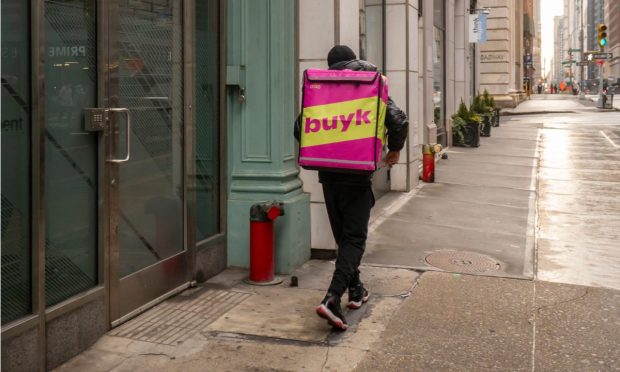Ultrafast Grocery Delivery Moves to the Midwest as Competition Heats Up

While ultrafast grocery delivery services operating in New York City — a list that currently includes Getir, Buyk, Jokr, Fridge No More, Gorillas, 1520 and DoorDash — compete to win the loyalty of the crowded market’s early adopters, much of the rest of the country remains hugely underpenetrated. Yet, with the majority of these businesses’s aggressive expansion strategy, this disparity will likely be short-lived.
Last week (Dec. 29), Buyk, a company created by the founders of Russia’s Samokat ultrafast eGrocer, announced its Chicago launch, aiming to expand the category inland and reach new customers. While early customers tend to look the same across markets, Buyk hopes to develop over time to target the unique needs of each of the areas in which it operates.
“We think that there’s an opportunity to treat these markets and subsequent markets throughout the U.S. differently, that through our focus on a hyperlocal assortment we can really cater to the differences in the markets,” Buyk CEO James Walker told PYMNTS in an interview. “Obviously, everybody’s going to buy Diet Coke and water, bread, milk, eggs — those things are universal. But really catering to the unique assortment driven by that hyperlocal customer is ultimately where we want to be in a market-by-market basis.”
Research from PYMNTS’ 2021 How We Eat Playbook, created in collaboration with Carat from Fiserv, which surveyed more than 5,200 U.S. adults about their purchasing behaviors, found that 43% of all consumers are ordering home delivery for their restaurant meals or groceries more often now than they did before March 2020. Additionally, the study found that 88% of those who have shifted their grocery purchasing behaviors online plan to maintain these habits even when contagion concerns subside completely.
Read more: Restaurants and Grocers See Path to Picking up 200 Million New Customers
The New Digital Consumer
Before joining Buyk in November, Walker had worked as senior vice president of restaurants at Nathan’s Famous, where he spearheaded a rapid rollout of ghost kitchen locations. Now, in the grocery industry, he is dealing with a similar but slower-to-adopt customer, as grocery shoppers typically lag restaurant diners in shifting their purchasing habits online.
See also: Nathan’s Famous Doubles Down on Ghost Kitchens as Hottest QSR Trend Accelerates
Findings from PYMNTS’ study The Bring-It-To-Me Economy: How Online Marketplaces And Aggregators Drive Omnichannel Commerce, another collaboration with Carat from Fiserv, showed that while 61% of consumers order restaurant-made food online, 57% use digital channels to buy groceries. Additionally, whereas 58% of consumers reported that they had been ordering food online more than they used to prior to March 2020, only 46% said the same of grocery purchases.
Read more: Bring-it-to-Me Economy Ascends as Consumers Embrace Home-Centric Lifestyles
“There’s certainly overlap between restaurant customers and prepared, ready-to-eat food buyers and grocery customers, but I think there’s new customers,” he said, citing the examples of consumers stuck at home taking care of children or struggling with health challenges.
According to data from the playbook, members of Generation Z, millennials and bridge millennials typically make up the bulk of grocery delivery services’ first customers, while older adults have been slower, with fewer than half of all baby boomers and seniors ordering groceries online for delivery compared to 90% of Gen Zers.
The DoorDash Issue
The entry of DoorDash, a giant of on-demand fulfillment, could raise challenges for others in the ultrafast delivery space.
“I think it’s very interesting, and I would say not surprising, that DoorDash would enter it at this point in time,” said Walker, noting the widespread demand on consumers’ side for services of this kind.
One major advantage that DoorDash has relative to newcomers is an existing customer base already engaging with its offerings, according to data from PYMNTS’ report Digital Divide: Aggregators and High-Value Restaurant Customers, created in collaboration with Paytronix, which surveyed more than 2,100 U.S. adults about their food ordering habits.
See more: Restaurants Must Sharpen Digital Tools to Match Convenience of Delivery Aggregators
Of the 668 respondents who used an aggregator to place an order from a restaurant in the past 15 months, 57% had used DoorDash, making it far and away the most popular pick compared to the 50% who had used Uber Eats, the 48% who had used Grubhub, and the 25% who had used Postmates.
Walker argued that, even with major businesses such as DoorDash (and possibly soon Instacart) making moves into ultrafast, there will be enough demand to support many competitors in the space.
Read also: Instacart’s Reported Entry Into Ultrafast Delivery Could Be Devastating to Newer Startups
“Currently [ultrafast is] a very small percentage even of overall online grocery … so there’s certainly room for more players in the market,” he said. “I wish them a lot of luck. Barrier to entry into the market is low, but barrier to success is very high.”
Make or Break
Walker noted that the trend toward convenience had been well underway before the start of the pandemic, although it was accelerated in 2020, suggesting that demand will endure long after contagion concerns subside. Still, although demand is considerable, he said he expects some consolidation, predicting that only those that can meaningfully differentiate their offerings will stick around for years to come.
“I think as ultrafast grocery begins to mature, we’ll see some shakeout,” he said. “Players that are very focused on the business model as well as the customer experience ultimately will be successful, and those that are not spending the requisite amount of time will not be as successful.”
